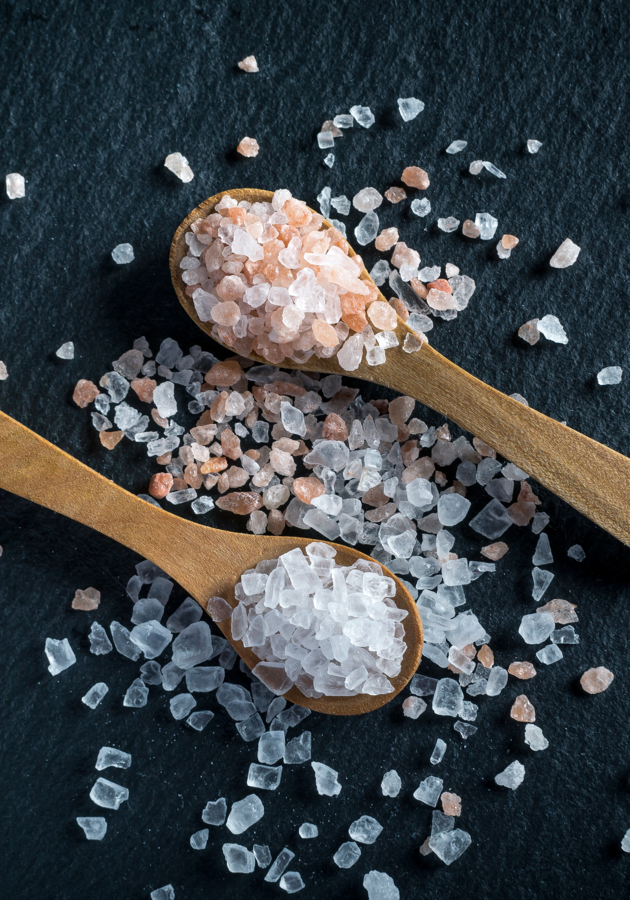In his 1776 magnum opus, “The Wealth of Nations,” Scottish economist Adam Smith pointed out, slightly tongue-in-cheek, that “salt is said to be a common instrument of commerce and exchanges in Abyssinia.” Just a century before Smith’s birth, however, his own country couldn’t provide enough salt for its fisheries and had to import most of it from France. Consequently, many of Britain’s seventeenth-century leaders spoke with urgency about “the dangerous national dependence” on French sea salt.
Though these two examples may seem strange (and even comic) to modern readers, salt was a matter of grave concern for our ancestors. Indeed, as Mark Kurlansky shows in “Salt: A World History,” it was only recently that things changed. For most of the past, salt was as valuable a commodity to humans as oil is today. It served not only as currency, but it also established cities and trade roads, provoked and financed wars and inspired some of the most important revolutions of the modern age. That’s right: get ready for an unlikely history of salt, the only rock we eat!
A tale as old as time
An old French fable tells the story of a smart and humble princess banished from her castle for saying that she loved her father like salt. Years later, the story goes on, the king was invited to a wedding feast at a neighboring kingdom. Many varieties of heavenly dishes were served at the banquet, for it was the prince who was getting married. However, our king didn’t enjoy any of the dishes and ate very little. When asked by the bride what the matter was, he replied, in whisper, that all of the dishes, though carefully cooked, didn’t have any taste and were downright bland for some reason.
“It’s because they don’t have any salt in them,” said the bride, suddenly lifting her veil. “And did not I tell you, my dear and cherished father,” she went on to everyone’s surprise but the king’s, “that salt was the best thing in life? Yet, when I compared you to salt, to show how much I loved you, you thought slightingly of me and you chased me from your presence.” The king, repentant and overjoyed at the same time, embraced his daughter, and admitted in tears that he had been wrong to misinterpret her words. He blessed her marriage and wished his daughter and his new husband a happy married life. Then, of course, he asked the hosts for some salt, the value of which he promised to never put into question again.
“Salt is so common, so easy to obtain, and so inexpensive today that we have forgotten that from the beginning of civilization until about 100 years ago, it was one of the most sought-after commodities in human history,” remarks Mark Kurlansky, just after relaying this French folktale. Essential for life in general, salt is one of the oldest food seasonings, and salting was, for centuries, the most important method of food preservation. More than 14,000 different uses for salt are known today, including the manufacturing of pharmaceuticals, the freezing of ice cream, the melting of ice from winter roads, making soap, sealing cracks, softening water, and dying textiles.
It is an understatement to say that salt has shaped civilization: in fact, it has been pivotal to its very creation. Solnitsata, the earliest known town in Europe, was a salt mine. Located in present-day Bulgaria, the town (whose very name means “saltworks”) supplied the Balkans with this important mineral since at least 5400 BC. By then, however, the Chinese had been harvesting salt for no less than half a millennium. It is in China that our story begins, in the dry northern province of Shanxi.
An essential, edible rock
A landlocked province in North China, Shanxi is an arid region of desert mountains, which surround dry, yellow earth and a small lake known as Yuncheng. Eight millennia ago, numerous wars were fought for control of this lake. The reason? Every year, as the sun evaporated its waters in the summer, the locals were able to collect sparkling square crystals on its surface. We call these crystals salt.
Chemically, they consist largely of sodium chloride, an ionic compound with the formula NaCl. In itself, sodium is an unstable metal that can suddenly burst into flame, and chlorine, a deadly poisonous gas. Together, however, these two elements form a tasty rock, the only one we can actually eat. It has a specific taste which is registered by the simplest receptor in the mouth, the sodium chloride receptor. We call this taste “salty,” and list it among the five basic tastes.
Salt is an essential element for life. Chlorine makes digestion and respiration possible. Without sodium, the body would be unable to transport nutrients or oxygen, transmit nerve impulses, or even move muscles, including the most important one – the heart. Unfortunately, the human body is incapable of producing sodium. Moreover, it constantly loses both sodium and chloride through bodily functions. That’s why we consume salt. Unless we replace the lost salt, we’ll die.
Ancient people discovered another important property of salt – that it preserves. This was one of the most important discoveries in the history of civilization. Salt’s ability to preserve organic materials eliminated seasonal availability of food, and made it possible for people with access to salt to transport food over large distances. Until modern times, salt was the principal preserver. That’s why some of the earliest settlements developed around saltworks. The one in Shanxi, China, is considered the oldest in the world.
Salt in ancient times
It didn’t take long for the Chinese to understand the process behind the natural creation of the Yuncheng salt crystals. So, they began to produce the salt themselves, by boiling saline oceanic water. Many millennia later, thanks to the ingeniousness of a hydraulic engineer named Li Bing, the Chinese also became the first culture to discover that salt can be found underground: the first brine walls in the world were drilled in the province of Sichuan in 252 B.C. Even today, the Sichuan Chinese enjoy eating pickled vegetables with unsalted rice.
Ancient Egyptians had an appreciation for vegetables preserved in salt as well. “There is no better food than salted vegetables,” says an ancient papyrus. Even more importantly, the ancient Egyptians were probably the first to cure meat and fish with salt, and the first to preserve food on a large scale. They were also the first to preserve human corpses in salt as well. Quite probably, that’s how the process of mummification began.
Salt was valued highly by the Hebrews as well, who believed – just like the Muslims after them – that salt protects against the evil eye. Moreover, they also believed that God’s covenant with them was as eternal as salt. The phrase “covenant of salt” appears twice in the Bible, once in the Book of Numbers and another time in the Chronicles. Appropriately, to show their trust in God, ancient Hebrews mentioned him while sprinkling salt on their offerings.
Ancient Romans were the first to build large-scale roads specifically for the transportation of salt. Via Salaria – or, the Salt Road – is a famous example. It ran from Rome to the Adriatic coast and was used to transport salt from Rome to other cities across the Italian Peninsula. As Rome expanded, transporting salt became too costly, so the Romans began establishing and conquering strategic saltworks. They also began paying the army in salt. Hence the origin of the word “salary,” which can be loosely translated as “money consisting of salt.” The etymology of the word “soldier” is also related.
Salt in medieval times
When the Romans defeated Carthage in the Third Punic War, Scipio Africanus is said to have ordered that their countries be ploughed over and sowed with salt, as a curse on their re-inhabitation. This is believed to be an old ritual originating in the ancient Near East. In fact, one of the oldest examples of the practice can be found in the Bible, specifically in the Book of Judges. Salt was, in other words, used to symbolically destroy empires. In the Medieval Ages, it also created them.
The Celts of Medieval Europe owed a large share of their wealth to their salt mines. Thanks to the Romans, they also owe the name by which they are remembered today to salt: Gauls. “Gaul” is a Roman variant of the Ancient Greek word for “salt” – hal. Put simply, for the Romans, the Celts were the salt people. Indeed, they were. The German city of Halle, the Austrian towns of Hallein, Swäbisch Hall, and Hallstatt, as well as the identically named regions of Galicia in northern Spain and southern Poland – all owe their names to the Gauls. All of them were Celtic saltworks during the Medieval Ages.
Hallstatt and Hallein lie on the river Salzach, on which the city of Salzburg, the birthplace of Mozart, lies as well. Salzach literally means “salt river” and Salzburg “salt castle,” both taking their names from the German word for “salt” – Salz. In Anglo-Saxon England, the suffix “-wich” in a place name usually means that place was once a source of salt. The “-wich towns” of Cheshire and Worcestershire were England’s leading salt producers after the Norman conquest. Later, it was thanks to the great Cheshire salt mines that the city of Liverpool became the second-most important English port, after London.
In the 13th century, the Italian cities of Venice and Genoa fought a war over the control and price of salt and spices. Their influence, however, waned during the Age of Exploration, as new trade routes to India and the Americas were discovered. The salt mines of Wieliczka and Bochnia turned Poland into an important political factor during the 16th century, but when its neighbors brought in sea salt, its power diminished and Poland was partitioned between Austria, Prussia and Russia. In 1772, the country vanished from the maps of the world. Just four years later, another one appeared on the other side of the Atlantic, the United States. Its creation had a lot to do with salt.
Salt in modern times
The Chinese were the first to realize that salt was a great tax generator. Already in 7th century B.C., a minister advised the ruler of the state of Qi to fix the price of salt at a higher level than the purchase price so that the state could both import the salt and sell it at a profit. In the years that followed, the Chinese state gained complete control of the manufacture of salt. Even though controversial, the state salt monopoly stood for long periods of time, financing wars and expeditions to the West.
In France, millennia later, it mostly financed the lavish lifestyle of its kings. Enacted in 1286, the gabelle was a very unpopular tax on salt that lasted all the way to the French Revolution. The salt tax propagated extreme regional disparities in salt prices of such kind that population shifts weren’t a rarity. Unsurprisingly, one of the first acts of the National Assembly in the midst of the French Revolution was to abandon the gabelle. However, the tax was reinstated by Napoleon Bonaparte in 1806 only to be abolished in 1945.
The British ruled their dominions in a similar manner. When they noticed that the early settlers of the American continent grew self-reliant on salt by harvesting it themselves, they began raising taxes on salt in the colonies, while making British salt less expensive. Unjust taxes such as these eventually sparked the American Revolutionary War which led to the creation of the United States. Even though Britain recognized the country’s independence, its armies visited the continent once again after the Napoleonic Wars in an attempt to restrict US trade. During the ensuing war, British soldiers tried to destroy the newly created American saltworks, whereas American soldiers – just like their Roman counterparts, millennia before them – were paid in salt brine, as the federal government was too poor to pay them with money.
British salt tax was responsible for the creation of another great country: India. To facilitate the import of English salt from Liverpool and enable its sale in India, the British East India Company imposed special taxes on Indian salt in 1835. In the century that followed, just like the American settlers before them, Indians had to pay a lot of money for British salt, and weren’t allowed to use their own. That all changed in 1930, when civil rights leader Mahatma Gandhi led a group of followers on a 240-miles-long march to the coastal village of Dandi where he announced that he would break British law by harvesting salt. After raising a lump of salty mud, he memorably declared, “With this, I am shaking the foundations of the British Empire.” The rest, as they say, is history. India’s history.
Final notes
Mark Kurlansky made a name for himself in 1997 when Penguin Books published “Cod: A Biography of the Fish That Changed the World.” Since then, he has written several similar single-topic histories, neither of which have fatigued his critics or dedicated readers. For a reason: they are all amusing, eye-opening, and wonderfully written. Published in 2002 – at least in our opinion – “Salt” may be the best one of the bunch. Recommended.
12min tip
Check out our summary of A History of the World in 6 Glasses by Tom Standage, which packs thousands of years of human history into six drinks: beer, wine, coffee, tea, spirits, and Coca-Cola.





























